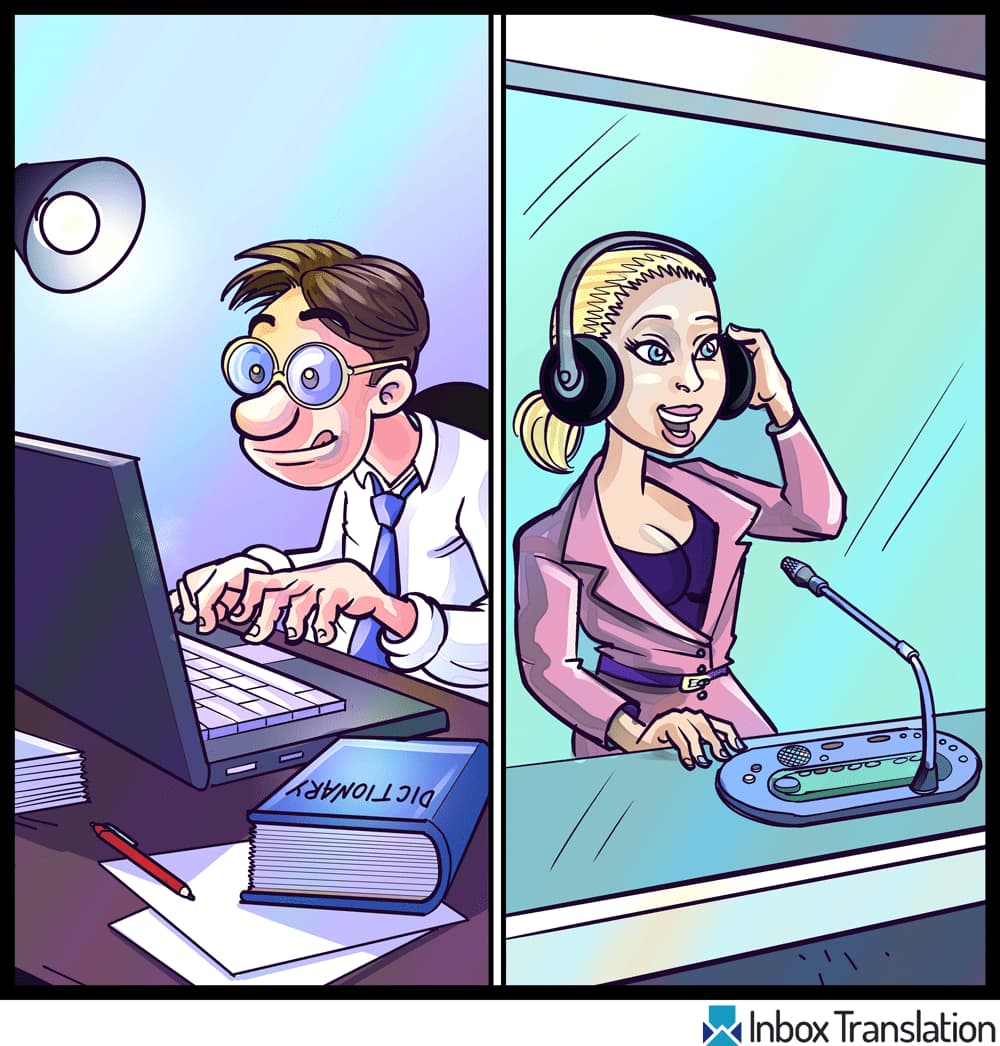Translator vs interpreter – differences (and similarities)
Author: Alina Cincan | Last updated 9 January 2022
To put it simply, a translator works with the written word, the interpreter with the spoken language. In other words, translators type while interpreters speak (unless they interpret in a sign language).

Why this resource?
This conundrum is one that’s been debated for years and has sparked numerous discussions, especially online. Every time a media outlet wrongly uses the term translator when they meant interpreter, there is usually an outpouring of messages/comments to let them know what the difference is. Try searching for “interpreter, not translator” on Twitter. 🙂 You’re in for a ride.
Also, in our recent research study on the NHS spending on translation and interpreting services, it became clear that most people outside the field do not know how to differentiate between the two terms.
Differences
| Translators | Interpreters | |
|---|---|---|
| Languages | Translators usually translate into their native language | Interpreters can work in both directions |
| Place | Work from home | Traditionally on site (think conferences, business meetings etc.), but remote work is also possible |
| Teams | Work by themselves | Simultaneous interpreters work in pairs, the others on their own |
| Time | Work against deadlines but can consult reference materials and edit their work | Interpret on the spot (simultaneous) or with a short delay (consecutive) |
| Accuracy | Can refine their translation | No time to look for that perfect word |
| Rates | Usually charge per word, per page, per line, or per project | Charge per hour or per day (sometimes per half-day) |
| Cancellation policy | A charge covering the work done | Could charge up to the full rate |
| Tools | Computer, CAT tools, dictionaries, glossaries | Headsets, microphones, sometimes pen and paper |
| Challenges | Deciphering handwritten text (like a doctor’s note) | Jokes and cultural references |
| Examples of work | Contracts, books, medical records, academic transcripts and diplomas, websites, apps, subtitles | Court proceedings, business meetings, conferences, interviews, speeches |
| Extra costs | None | Travel, meals, accommodation if attending an event on site |
Languages
Translators usually translate into their native language only (the cases where they translate from their native language into their second language are rare – for example, it is not easy to find a qualified Swahili or Vietnamese into English translator who is native in English). Interpreters can work in both directions (apart from conference interpreters who work in one direction only).
Place
As revealed by our freelance translator study, 99% of freelance translators work from home at least some of the time, and that’s without taking in consideration any COVID-19-related restrictions. In the case of interpreters, this depends on the type of interpreting:
- Telephone interpreters will most likely work from home, or at least they would need a quiet place that also offers privacy and confidentiality.
- Conference interpreters: traditionally, they work at the event venue, in a soundproof booth. The COVID-19 pandemic has forced this field to change things and adapt, and a lot of events moved online, so there was a rise in remote simultaneous interpretation, where interpreters could offer their services from home via video (on dedicated platforms).
- Liaison interpreters: like with conference interpreters, liaison interpreters had to be present physically at the client’s venue (for example a meeting room), with more of these events moving online since the start of the pandemic. Video interpreting is in full swing.
There is also a running joke about this: if they can work dressed in pyjamas, they are translators. If not, they are interpreters. The new way of working has changed all that, so remote interpreters can still wear pyjamas as long as it doesn’t show on camera. 🙂

Teams
Simultaneous interpreters (conference interpreters) work in pairs, swapping every 20 minutes or so, while translators work by themselves. The reason why simultaneous interpreters need to work this way is because this type of interpreting is extremely taxing and research has shown that interpreter fatigue leads to errors. Translators can also work in pairs, i.e., with a colleague to act as an editor/proofreader.
Time
Translators have time on their side (even if they do work against deadlines), and they can consult reference materials (dictionaries, glossaries etc.), use various tools (spell checkers, computer-assisted translation tools, term bases), and can also review and edit the text after translating.
On the other hand, interpreting happens on the spot (simultaneous) or with a short delay (consecutive), which means that interpreters have to rely on their knowledge of the language and of the subject matter, as well as on their memory. However, interpreters prepare in advance (how much in advance and what kind of preparation will depend on a number of factors: type of event, materials available etc.) They normally do some research on the topic and terminology (no matter how well they know the subject matter, each event is unique), they will ask the client for any available slides (if a presentation is delivered), videos that will be played etc. Sometimes though, this is not always possible, especially in liaison interpreting. Which brings us to the next point:
Accuracy
As interpreters need to think on their feet and render the message on the spot, they have no time to look for that perfect word or expression (as a translator might do), but retain the overall message of the speech. Translators can refine their translation to ensure completeness, accuracy, and fluency. Sometimes, they work with an editor/proofreader to ensure the final text is flawless and ready for publication.
Rates
Translators usually charge per word, per page, per line, or per project. Interpreters charge per hour or per day (sometimes per half-day).
Cancellation policy
For translation, if the work is cancelled after the work has started, a charge covering the work done or a minimum charge (whichever is higher) would apply.
For interpreting, this charge depends on how much in advance the assignment is cancelled. Interpreters will have reserved that time (usually the entire day) for an event, without being able to take any other jobs, so if this is cancelled with short notice, then they would not be able to take on anything else, not to mention the time spent preparing for that assignment. Therefore, they need to charge a fee to cover this.
Tools
Translators use a computer, CAT tools, dictionaries, glossaries, and they type their work. Interpreters use headsets, microphones, sometimes pen and paper, sometimes no tools at all. They speak(or sign – for sign languages) their work.
Challenges
For translators (remember they work with written texts), it could be deciphering a handwritten doctor’s note; for an interpreter, it could be a joke the speaker decided to make (hint: jokes usually don’t translate well – neither do cultural references or wordplays – and having to do that on the spot is nigh on impossible).
Extra costs
When an interpreter needs to attend an event (be it a conference, business meeting) for which they need to travel (and some events can span over a few days), there are costs associated with this (travel, meals, accommodation) and these expenses are covered by the client. Translators (as well as interpreters who work remotely) do not have such costs associated with their work.
Examples of work
| Translators | Interpreters |
|---|---|
| Legal work: contracts, court documents (witness statements, judgments, etc.) | Simultaneous interpreting: conferences, training |
| Medical work: clinical trials, medical records, patient information | Consecutive/Liaison interpreting: court proceedings, business meetings, interviews, police, hospitals, speeches, field military liaison with local population |
| Other: literature (books), academic transcripts and diplomas, websites, apps | Telephone interpreting: police, hospitals |
If you can see their work, they are translators. If you can hear their work, they are interpreters.
Special case: Sign language interpreters’ work can both be seen and/or heard depending on the type of event.
Similarities
As you can imagine, there would be no confusion between translators and interpreters were they not similar, so let’s also look at what makes them alike.
- they work with languages
- are freelancers
- are highly skilled and trained
- need to have excellent cultural awareness
The most obvious one is the fact that they both work with languages, and that means at least two (including their native language/language of habitual use).
Most translators and interpreters work as freelancers.
Some translators also work as interpreters and vice versa, though most of the time they will have a strong preference for one or the other. Out of the 1,500+ translators who filled in our survey, 19% work both as translators and interpreters, while 62% work exclusively as translators.
Professional translators and interpreters are highly skilled and trained (only 7% of translators for example have come to the profession with no formal degree, the rest of 93% have at least one degree – one of the key findings of our research on freelance translators), and are usually members of professional associations such as the Chartered Institute of Linguists, the Institute of Translation and Interpreting in the UK, the American Translators Association, the Association of Translation and Interpreting Professionals (Associação de Profissionais de Tradução e de Interpretação – APTRAD) in Portugal, the French Association of Translators (Société française des traducteurs – SFT) in France etc.
Both translators and interpreters need to have excellent cultural awareness (including idioms, customs, level of formality) and subject matter expertise. For example, any reference to Marmite will fall flat outside the UK, so a translator would need to adapt and come up with a reference that will produce a similar effect. In a business meeting, a French interpreter will know whether they will need to use ‘tu’ or ‘vous’ for the English ‘you’.
Examples of misuse
When the media gets it wrong (and in most cases – if not all – they refer to interpreters as translators):
Sharon Choi: how we fell for Bong Joon-ho’s translator
Box Office: ‘Parasite’ Eyes $150 Million After Golden Globes Win
I worked as a translator for migrants in detention centres. Here’s what I learned (though the article correctly uses the term ‘interpreter’, the title says ‘translator’)
Man charged in connection with Christmas Day Banteer stabbing (hint: if it’s court proceedings, that’s an interpreter)
